Published: 27 October 2020 | Category: Technical advice note | Audiences: Road traffic engineers & consultants, Roading contractors
The purpose of this technical note is to provide some high-level recommended practice to contractors carrying out the installation of tactile pavers as requested in an industry survey in 2018. This is a supplementary publication aimed at roading and utility contractors to provide a simple guide for reinstating tactile pavers affected by their works.
 The purpose of this technical note is to provide some high-level recommended practice to contractors carrying out the installation of tactile pavers as requested in an industry survey in 2018. The comprehensive advice on design principles and installation for tactile indicators is unchanged: please refer to RTS14 – Guidelines for facilities for blind and vision impaired pedestrians (3rd edition, 2015). This is a supplementary publication aimed at roading and utility contractors to provide a simple guide for reinstating tactile pavers affected by their works.
The purpose of this technical note is to provide some high-level recommended practice to contractors carrying out the installation of tactile pavers as requested in an industry survey in 2018. The comprehensive advice on design principles and installation for tactile indicators is unchanged: please refer to RTS14 – Guidelines for facilities for blind and vision impaired pedestrians (3rd edition, 2015). This is a supplementary publication aimed at roading and utility contractors to provide a simple guide for reinstating tactile pavers affected by their works.
The upcoming Pedestrian Network Guidance to be launched in 2021 will provide more comprehensive detail on installing tactile indicators including case studies showing installation examples.
Correctly installed tactile ground surface indicators (TGSIs/ tactile paving) will result in safer and more accessible environments for all people and particularly those who are blind or have low vision. The purpose of this note is to clarify and reinforce the key principles for installing standard tactile indicator layouts for typical crossings and intersections. It provides guidance to transport and roading engineers and contractors involved in urban road design and construction. The content includes the installations most commonly affected by small works. When the Pedestrian Network Guidance is launched, this technical note will be reviewed to ensure the advice is still appropriate.
There may be local council design specifications that need to be adhered to. If there is insufficient detail on the drawings, contact the designer or Blind Low Vision NZ representative for further assistance.
There are two types of tactile indicators permitted in New Zealand: warning indicators and directional indicators. These are described below.
Note that the continuous accessible path of travel defines the area where the pedestrian route is safe and obvious for everyone. It has even surfaces, gentle slopes and is free of obstacles at all times. It is very important when doing reinstatement works to ensure that the design principles in RTS14 still apply and there is continuous guidance re-established along important pedestrian routes.
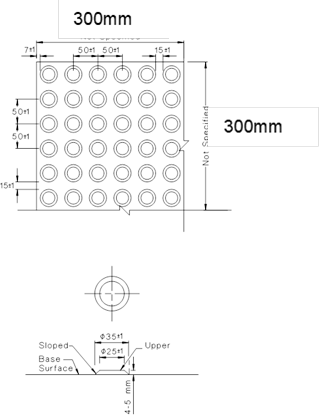 Warning indicators alert pedestrians to hazards in the continuous accessible path of travel indicating they should stop before proceeding further. Install warning indicators at all pedestrian crossing points (formal and informal), railway platforms, bus boarding positions, railway crossings, approaches to stairs, ramps and escalators.
Warning indicators alert pedestrians to hazards in the continuous accessible path of travel indicating they should stop before proceeding further. Install warning indicators at all pedestrian crossing points (formal and informal), railway platforms, bus boarding positions, railway crossings, approaches to stairs, ramps and escalators.
Install warning indicators using the following key principles:
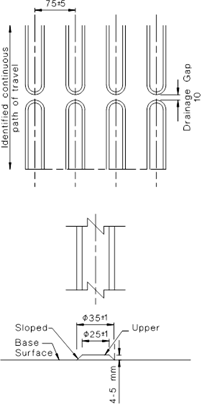
Directional indicators should only be installed where a person must deviate from the continuous accessible path of travel to gain access to a road crossing point, public transport access point or significant public facility.
In most instances, blind and visually impaired people use the building line as a guide. Directional indicators are required when a crossing point is not located on the accessible path of travel, or if guidance is required to keep them on the accessible path.
Do not over provide directional indicators. Other features such as landscaping may be better used for orientation and navigation. Directional indicators should not be installed if the space between the edge of the warning indicators to the back of the path is 1m or less.
 The products used should meet the slip resistance and visual contrast requirements for New Zealand and be installed using the dimensions and layouts set out in this guide. Typically, tactile indicators are yellow or white. Only install green warning tactile indicators on a designated cycle crossing.
The products used should meet the slip resistance and visual contrast requirements for New Zealand and be installed using the dimensions and layouts set out in this guide. Typically, tactile indicators are yellow or white. Only install green warning tactile indicators on a designated cycle crossing.
Precast concrete slabs are the simplest and most effective way to install tactile paving. The pavers are precast 300x300mm and typically 60mm deep. Mark out and check the location of each paver before cutting. Choosing the right product for the specific location is fundamental to providing tactile paving that will be durable and cost effective. Therefore, when selecting other tactile indicator products, it is important to understand the installation and maintenance regime of the product and its suitability for your project.
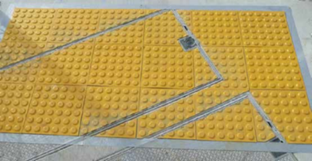 If tactile indicators are required where public utility services are present, f manholes, review the proposed design or install the tactile indicators over the existing surface. Work with the designer to investigate if the services can be relocated or amend the design to extend the kerb to provide adequate space for tactile indicators without relocating services. If the only option is to install over the services, polyurethane paving options provide the most flexible installation option. An example of a practical application of this option is shown (right).
If tactile indicators are required where public utility services are present, f manholes, review the proposed design or install the tactile indicators over the existing surface. Work with the designer to investigate if the services can be relocated or amend the design to extend the kerb to provide adequate space for tactile indicators without relocating services. If the only option is to install over the services, polyurethane paving options provide the most flexible installation option. An example of a practical application of this option is shown (right).
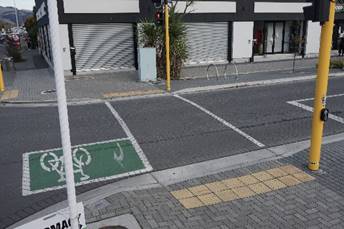 The location of the push button, kerb crossing and tactile indicators in relation to each other is important. If the push button and kerb crossing are not correctly placed in relation to each other, check with the designer before installing the tactile indicators.
The location of the push button, kerb crossing and tactile indicators in relation to each other is important. If the push button and kerb crossing are not correctly placed in relation to each other, check with the designer before installing the tactile indicators.
If the environmental features do not provide adequate cues to continue on the accessible path, then directional indicators will be required. Install the directional indicators so they lead the user to the side where the push button is located at traffic signals.
Table 1 and Figures 1 and 2 below outline the typical layout and dimensions for tactile indicators at a crossing or intersection.
Table 1: Tactile indicator layout dimensions
| ID |
DESCRIPTION |
DIMENSION |
|
Tactile indicator layout dimensions |
||
|
A* |
Set back distance of warning indicators to face of kerb |
Minimum 300mm |
|
B |
Depth of warning and directional indicators |
Minimum 600mm |
|
C |
Width of kerb ramp and warning indicators*** |
Recommended 1.5m (Minimum 1.0m) |
|
D |
Distance between directional indicators and back of footpath |
Max 150mm |
|
E |
Distance between warning indicators and back of footpath |
If less than 1.0m then no directional indicators required |
|
Relevant traffic signal layout dimensions |
||
|
F |
Width of pedestrian crosswalk |
Recommended 2.5m |
|
G |
Clearance between push - button pole and edge of kerb ramp |
Maximum 300mm |
|
H |
Pedestrian push - button set back from kerb |
Minimum 600mm |
Notes
* Dimension A is measured along the path of pedestrian travel, not perpendicular to the kerb.
** Where the kerb is not perpendicular with the crossing direction, a suitable tactile indicator arrangement will result in a variable Dimension A. Dimension A must not exceed 1m; a staggered tactile indicator arrangement can overcome this.
*** The warning indicators must cover the full width of the kerb ramp to ensure that a person will receive underfoot tactile warning and not accidentally bypass the warning indicators. Refer staggered tactile indicator layouts for further guidance.
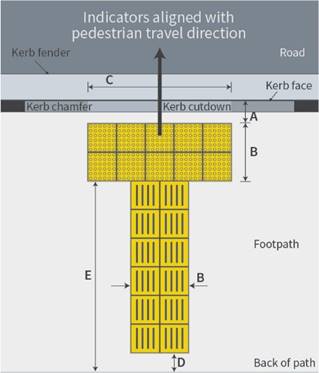
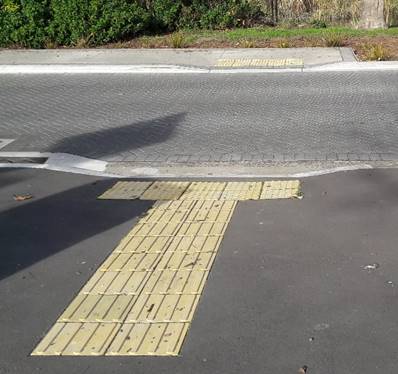
Figure 1: Typical tactile indicator layout
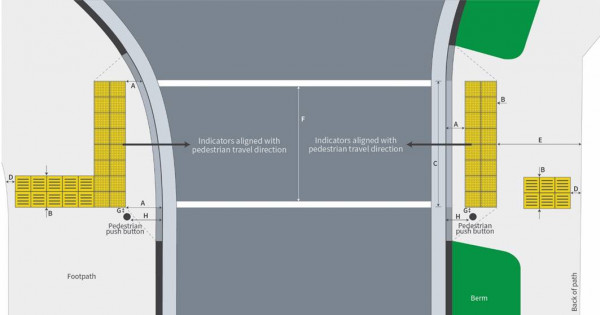
Figure 2: Typical layouts at traffic signals
Where the radii of the kerb does not permit a tactile arrangement with a straight leading edge, a staggered layout of warning indicators is permissible as shown. Staggered warning indicator layouts should be as simple as possible whilst ensuring they are placed 900mm deep at the transition to avoid a pedestrian overstepping them.

If you think these requirements cannot be achieved, liaise with the designer or Blind Low Vision NZ representative prior to installing the tactile indicators.
Author: Waka Kotahi NZ Transport Agency
Published: September 2020
Version: 9
Found at: https://www.nzta.govt.nz/walking-cycling-and-public-transport/walking/walking-standards-and-guidelines/
To submit documents or if you have any questions or feedback, please contact the Team Leader – Multi-Modal at multimodal@nzta.govt.nz
[signed]
David Darwin - Chair, Ratification Group
Vanessa Browne - Delegated Approver